by Naomi L. | December 6, 2013 | J.C. Wolfe's Writing, Poetry |
A movie is like a painting.
A vision of art for the eyes,
The artist projects it for the world
So that viewers may gaze
Upon its beauty.
Its colors and shapes are a landscape,
With a range of depth and movement
As envisioned by its creator.
Like a painting,
A movie evokes emotion.
It stirs the mind
And touches the heart.
It gives a glimpse of another world.
Like the classic still paintings
Hanging in many a museum,
So is the movie
A work of art.
A book is like a door.
Dull and common it appears
As it stands still and untouched,
Waiting to fulfill its only function.
No beauty arises from a still frame;
Its beauty lies in its purpose.
Like a door,
A book does nothing when untouched.
But when opened,
It becomes a gateway into another world.
In a change of scenery
Lie the colors and shapes,
The depth and movement,
The beauty one seeks
In a vision of art for the mind.
Like many simple doors
Standing innocently in their frames,
So is the book
A portal for art.
A movie can only take you so far.
It has its twists and turns,
Its sights and sounds.
But at the end of the ride,
You find yourself right back where you started.
Because to take you somewhere new,
A movie relies
On someone else’s imagination.
A book can take you anywhere.
Its paths can be straight or crooked,
Colored or grayed.
At the end of the ride,
You find yourself in a different world.
Because to take you somewhere new,
A book relies
On your imagination.
Please, keep your paintings.
I’ll show myself the door.
by Naomi L. | October 9, 2013 | Blog, Creative Writing, Featured |
The new Romeo & Juliet movie is coming to UK and US theaters this Friday (which I admit makes me totally jealous, since there’s no set release date for where I live yet). In the spirit of celebrating one of William Shakespeare’s most famous plays, today’s topic is centered around this classic tale of love, fate and tragedy.
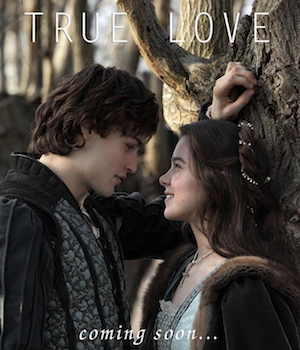
Douglas Booth and Hailee Steinfeld as Romeo and Juliet
Now I’m going to make a confession: I absolutely love this story. I love any story about forbidden love (as long as it’s well-told), and being the epitome of such a tale, Romeo & Juliet may be one of my favorites. In fact, I love it so much that I’ve read scenes several times over (yes, I read Shakespeare for fun, believe it or not), have actively sought out a fair share of adaptations, and have even used it as inspiration for my own romantic fiction.
But don’t mistake me for a silly fangirl. For the longest time, I believed the common interpretation that Romeo and Juliet were no more than two immature teenagers who recklessly rushed into a superficial relationship at the ultimate expense of their families and the rest of Verona. It wasn’t until I started researching in-depth analyses of the story (again, for inspiration) that I came to understand what I was missing in Shakespeare’s timeless classic, and what most modern readers/viewers might be missing too.
So to set your impressions straight before you head out to see this movie, here is a list of five points in Romeo & Juliet that you probably never noticed before. Get ready to see another side of this story!
(Warning: the following list contains possible spoilers for Romeo & Juliet. If you’re one of the few people on the Internet who are not familiar with this tragic story, proceed with caution. Or you can just read a full summary of the plot here.)
1) Rosaline is an important character
Before Romeo meets Juliet and falls desperately in love with her, he actually has his sights set on a different girl: Rosaline. In fact, his very first appearance in the play has him moping to his cousin Benvolio about the unrequited love he claims to feel for this unseen lady, and he even agrees to crash the Capulet ball with his friends just for the chance to see her.
But other versions of the story tend not to place very much importance on Rosaline. Most adaptations don’t even give her a face, and some exclude her character altogether, instead providing a different explanation for the Romeo character’s depression before he meets his Juliet (e.g. West Side Story: Tony longs for excitement in his life, which he finally discovers upon meeting Maria). This common alternative likely stems from the assumption that Rosaline’s only purpose in the original story is to lure Romeo to the ball so he can cross paths with Juliet, a plot point that can be easily worked around (continuing from the previous example, Tony first encounters Maria at a local dance that he only agreed to attend as a favor to his best friend).
Yet Rosaline actually plays a much greater role than a mere plot device. While pining for her, Romeo has a preconceived notion of what it means to be in love, and acts according to the lessons he’s learned from the hackneyed romantic poetry he likes to recite when thinking of her. At the first sight of Juliet, however, he abandons every thought of his former clichéd infatuation in favor of a much deeper passion that sparks some incredibly beautiful and original love poetry from his own heart (which, when you think about it, may have been Shakespeare’s way of saying “Take that!” to the poets before his time). To put it simply, the switch from Rosaline to Juliet is essential to highlight the main characters’ true feelings for each other by showing the audience the difference between Romeo thinking he’s in love and Romeo actually being in love.
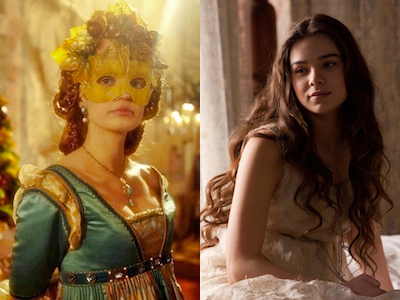
Seriously, did Rosaline ever stand a chance against Juliet?
What you’re probably thinking: He takes one look at Juliet and forgets about Rosaline just like that? Damn, Romeo is so superficial!
What you should be thinking: Wow, Juliet inspires such beautiful passion in Romeo! He must really love her!
2) Mercutio’s Queen Mab speech is a warning
One of the many famous monologues in Shakespeare’s works is the Queen Mab speech delivered by the bold Mercutio in Act 1, Scene 4 of Romeo & Juliet. This is the scene in which he teases Romeo for pining after Rosaline and tries to break his illusions of love by delivering a lecture about the dreams of men and how they can ultimately lead to ruin. Sound familiar?

“True, I talk of dreams,
Which are the children of an idle brain” (1.4.97-98)
Mercutio starts by talking about Queen Mab, the mythical fairy queen who rides through the night bringing pleasant dreams tailored to every sleeping individual. But as he goes on, the lighthearted speech quickly takes a morbid turn into a downward spiral through darker visions of depravity (from lovers dreaming of romance to soldiers dreaming of killing), until finally culminating in a bitter yet accurate portrayal of society. Instead of taking from the speech a lesson about realism and the twisted nature of humanity, however, the idealistic Romeo simply disregards his friend’s words as another of his many mischievous taunts, silencing him with a single exasperated comment, “Thou talk’st of nothing.”
Like Romeo, modern audiences might be inclined to dismiss the Queen Mab speech as unnecessary rambling that contributes little to the rest of the story. Indeed, the monologue’s main purpose is to illustrate Mercutio’s wit and roguish nature, but it can also be interpreted as a critique against the romantic ideals that drive the play’s entire plot. In a way, Mercutio’s speech is foreshadowing the tragedies that will occur over the course of the story, and while it isn’t necessarily important, it certainly adds an interesting subtext to the themes of Romeo & Juliet.
What you’re probably thinking: Man, Mercutio really likes to hear himself talk!
What you should be thinking: Mercutio knew a thing or two about realism. Romeo probably should have listened…
3) Paris and Lady Montague even the score
Remember that part near the end of the story when Romeo kills the Count Paris in the Capulet tomb, and that other part when Montague says his wife died of grief after their son was banished from Verona? No? Then you must be familiar with any version of Romeo & Juliet other than the original play itself.
The fact is, most adaptations of this play tend to exclude the deaths of Paris and Lady Montague because they don’t contribute very much to the plot. The latter even goes virtually unnoticed, her offstage death being summed up in only two lines. So why would the playwright even bother killing these characters off in the first place?
Because it’s only fair. Before Romeo and Juliet famously take their own lives at the end, two other important characters suffer dramatic deaths in the middle of the story: Mercutio and Tybalt. But wait, wasn’t Mercutio on the Montagues’ side? Yes, but he was not a member of their family, as Tybalt was of the Capulets’. Mercutio was actually from the third noble family in the play: the Prince’s. This means that after all four of these characters die, the House of Capulet would technically have suffered the greatest loss.
Unless one more family member were to be lost from each of the other two houses. Enter Count Paris and Lady Montague. Paris, though aligned with the Capulets, is another kinsman to the Prince, and ends up being killed in a fight with Romeo during his visit to Juliet’s tomb while she’s faking her death. A little later, after the bodies are discovered in the tomb, the Prince calls forth the heads of the feuding households, at which point Montague accounts for his wife’s absence by explaining that the news of her son’s banishment ended up killing her.
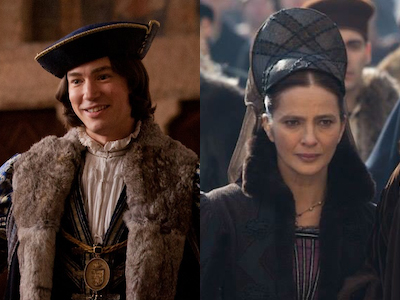
Surprise: one of them might not survive the movie this time. Guess who.
Final death toll:
- Capulets – 2 (Juliet and Tybalt)
- Montagues – 2 (Romeo and Lady Montague)
- Prince – 2 (Mercutio and Paris)
Conclusion: everyone loses, but at least in perfect balance.
What you’re probably thinking: Six people die by the end of the story? Shakespeare was twisted! No wonder most newer versions cut out these deaths!
What you should be thinking: Wow, every house loses two loved ones? How sad!
4) The poison and the dagger are symbolic

Romeo: “Thy drugs are quick. Thus with a kiss I die.” (5.3.120)
Juliet: “O happy dagger,/ This is thy sheath. There rust and let me die.” (5.3.169-170)
If there’s one thing for which Shakespeare was notorious, it was his innuendos. Plenty of his works contain their fair share of double entendres and the like, and Romeo & Juliet is no exception. However, instead of covering every example in the play (which would take a while, especially for scenes involving Mercutio), let’s just skip ahead to the one hidden in the famous double suicide ending.
You know how Romeo kills himself by drinking poison when he thinks Juliet is dead, and then Juliet stabs herself with Romeo’s dagger after she finds his body? Well, guess what: those two items are not random, but were carefully chosen to secretly represent the lovers’ intimate relationship. Romeo’s weapon of choice comes in a cup, which is a symbol of femininity. In contrast, Juliet uses a blade, a symbol of masculinity, to take her own life. In this way, their deaths are meant to reflect the intimacy they shared in life, thus completing the play’s theme of love ending in tragedy.
Or it’s all just another product of Shakespeare’s deviant mind, depending on how you choose to read into it.
What you’re probably thinking: Shakespeare must have been a misogynist, to have Juliet suffer a much more painful death than Romeo.
What you should be thinking: Even their deaths symbolize their intimate love. Shakespeare was clever with metaphors.
5) Romeo & Juliet is a coming-of-age story
Now I know what you might be thinking: how can Romeo & Juliet be a coming-of-age story if the entire plot only happens over four days? Perhaps it’s not a coming-of-age story in the traditional sense, as the teenage protagonists never actually reach adulthood, but their characters do mature throughout the course of the play, from the moment they meet to their untimely end.
At the beginning of the story, Romeo and Juliet are little more than naïve adolescents, both fairly inexperienced in life and in love. As soon as they first cross paths, however, they quickly propel each other toward the maturity of adulthood. Upon meeting Juliet, Romeo sheds his superficial conceptions of romance to become one of the most truly passionate lovers in all of English literature, and it is this passion that drives his actions for the rest of the play. Juliet, in turn, draws strength from her love for Romeo to develop into a confident and levelheaded young woman, making shrewd observations (“You kiss by th’ book”) and logical decisions that balance out her lover’s spontaneity. The intense love that outweighs the hatred around them makes their marriage all the more pure, and their loyalty to one another drives them to choose an eternity together in death over a miserable life alone. In short, though modern interpretations mistake these young lovers for foolishly infatuated teenagers, in-depth analyses reveal the true qualities of their complex characters, bringing to light the real depth of Shakespeare’s classic story of “death-marked love”.
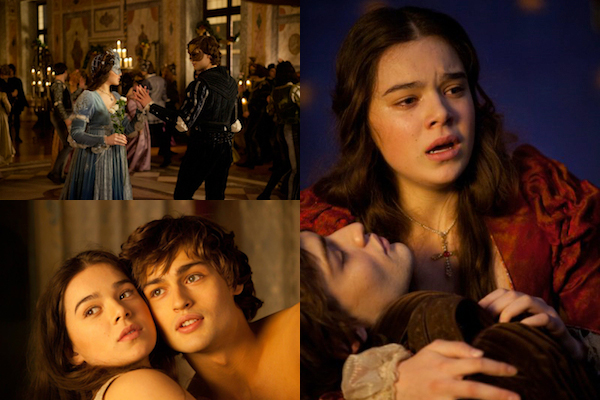
“For never was a story of more woe
Than this of Juliet and her Romeo.” (5.3.309-310)
What you’re probably thinking: They rushed into marriage after less than a day and then killed themselves because they couldn’t live without each other? Romeo and Juliet were so immature!
What you should be thinking: They were so young and they experienced such a grand romance. Romeo and Juliet were truly in love!
All caught up on these secret details?
Great! To leave you on a high note, here is the official trailer for the 2013 release of Romeo & Juliet (the original UK trailer can be found here). Enjoy!
[youtube=http://www.youtube.com/watch?v=Gp9yaZcrtnU]
Reasons I have high hopes for this movie:
- A screenplay adapted by Downton Abbey creator Julian Fellowes
- A stellar cast featuring talents such as Hailee Steinfeld, Douglas Booth, Ed Westwick, Damian Lewis and Paul Giamatti
- Good chemistry between co-stars Hailee Steinfeld and Douglas Booth
- Shot entirely on location in Verona and Mantua, Italy
I hope you’ve enjoyed reading about the secrets hidden in Romeo & Juliet! I understand that many will disagree with some of these points, but honestly, I think that’s part of the beauty of this tale: that it can be interpreted in so many different ways. To some, it’s a tale of love thwarted by fate; to others, it’s a warning about the dangers of being too impulsive. In any case, I’m sure we can all agree that this classic story has greatly endured the test of time, and will probably continue to intrigue admirers of Shakespeare and inspire the romantic at heart for generations to come.
On a final friendly note: kids, trust me when I say you do not want a romance like Romeo and Juliet’s! Yes, this is a beautiful story and a great one to read and learn from, but the story you want to live is that of Grandma and Grandpa, who had a life and grew old together. It’s important to know the difference!
Oh, and if anyone from the UK or US happens to watch this film, please let me know if it’s good. I’m very much looking forward to it. Thanks for reading!
(Disclaimer: All images and video in this blog post are courtesy of Swarovski Entertainment and Amber Entertainment. For news about the film, follow them on Facebook and Twitter. I own nothing; I’m just a fan hoping to spread the love. Thank you!)
by Naomi L. | October 2, 2013 | Blog, Creative Writing |
One of my favorite things about cinema is finding analogies in movies that are applicable to the real world. In much the same way I relate to the characters I read about in books, I often notice themes and metaphors in films for patterns I see in my life. Disney princess films showed me the (sometimes admirable, sometimes flawed) standards that women are expected to live up to; movies like How to Train Your Dragon touch on such subjects as the hidden value in an awkward youth who doesn’t quite fit in (the tried and true zero-to-hero plot) and the open-mindedness to see the world in a new light; and even films like Avatar appeal to my biologist side for the often clichéd but still valid theme of how the natural world is mistreated by the human race in general.
One interesting example I’ve found of an analogy for my creative side is from the 2010 movie Black Swan, which seems to reflect two different sides of my writing: technique and emotion. Of course, to understand this comparison, one first needs to be familiar with the story…
Rise of the Black Swan
As many are surely aware, Black Swan is an award-winning psychological thriller film, directed by Darren Aronofsky and starring Natalie Portman, Vincent Cassel, and Mila Kunis. The movie tells the story of Nina Sayers, a ballet dancer who is up for the highly coveted lead role of the Swan Queen in her company’s upcoming production of Swan Lake. In the beginning of the movie, the director, Thomas Leroy, is looking for a dancer who can embody both sides of the ballet’s main character: the delicate, innocent White Swan; and her sensual “evil twin”, the Black Swan. Thomas assures Nina that her flawless technique makes her a perfect match for the White Swan, but she must learn to let go of her inhibitions and release her emotional side in order to embrace the passion of the Black Swan. Despite her poor audition, the director sees enough of a spark in her to cast her as the Swan Queen, though he continues pushing her to bring out the fire he glimpsed when she asked for the part. The pressure of living up to her role proves incredibly stressful for Nina, and she soon finds herself transforming from her innocent White Swan persona into the dark Black Swan as she tries so hard to be “perfect”.
What really intrigued me about this film was seeing the contrast between the two Swans in creating the character of the Swan Queen. Though here they represent opposing sides of Nina’s personality, I find that they prove to be a good analogy for any form of art, which often requires a decent balance between both: the technique of the White and the emotion of the Black. In fact, the first comparison I made between the movie and my real life was not about my writing, but my singing. Back when I used to take vocal lessons, I focused so much on achieving technical perfection that I found it difficult to emote, for fear of losing that ideal sound. It wasn’t until later that I realized how applicable the concept was to all my other experiences in art, including – and perhaps especially – creative writing.
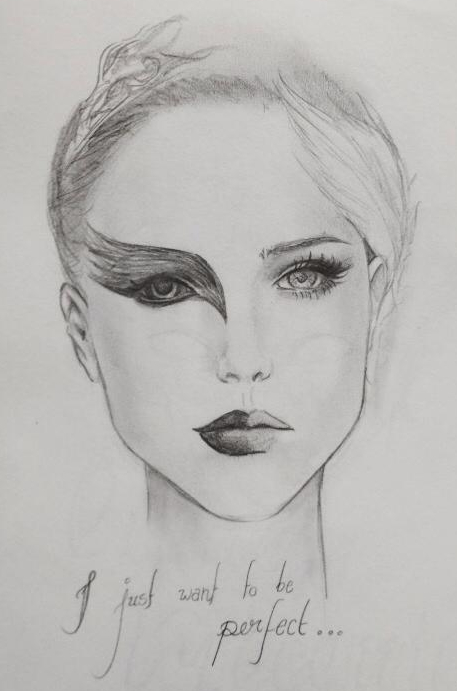
Natalie Portman as the Black and the White Swan
(Image used with permission from @angellastrucci. Check out her Instagram page for more amazing drawings!)
From Black to White
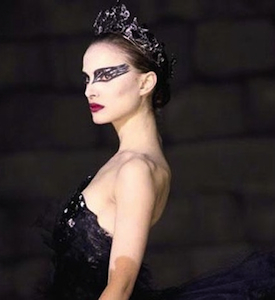 Interestingly, in contrast to Nina’s psychological breakdown, my own transformation seemed to happen backwards. Before I started seriously considering writing as a career, I wrote mostly for school assignments and my personal enjoyment, not really expecting to show my work to anyone. As a result of this, much of my earliest writing was carefree and uninhibited, but it was also rather sloppy. I think of this period as my “Black Swan” phase, when I poured my heart and soul into my words with hardly any regard for structure and refinement. For the preadolescent me, writing was all about emotion.
Interestingly, in contrast to Nina’s psychological breakdown, my own transformation seemed to happen backwards. Before I started seriously considering writing as a career, I wrote mostly for school assignments and my personal enjoyment, not really expecting to show my work to anyone. As a result of this, much of my earliest writing was carefree and uninhibited, but it was also rather sloppy. I think of this period as my “Black Swan” phase, when I poured my heart and soul into my words with hardly any regard for structure and refinement. For the preadolescent me, writing was all about emotion.
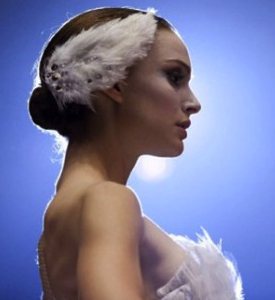 As I grew older, however, my approach to creative writing began to change. I started to pay more attention to the technical aspect of my stories, focusing on details like grammatical coherence and proper structure instead of putting pure heart into my writing. It actually got to a point where I was so obsessed with writing “correctly” that I would often write dialogue in proper language even if it wasn’t in tone with the characters involved in the conversation. Because of this, my stories started to become mechanical, lacking the spontaneity that used to come across so easily in my earlier works. This was my “White Swan” phase, when technique came first and I only worried about the feeling behind the words later. My teenage self was a technical perfectionist.
As I grew older, however, my approach to creative writing began to change. I started to pay more attention to the technical aspect of my stories, focusing on details like grammatical coherence and proper structure instead of putting pure heart into my writing. It actually got to a point where I was so obsessed with writing “correctly” that I would often write dialogue in proper language even if it wasn’t in tone with the characters involved in the conversation. Because of this, my stories started to become mechanical, lacking the spontaneity that used to come across so easily in my earlier works. This was my “White Swan” phase, when technique came first and I only worried about the feeling behind the words later. My teenage self was a technical perfectionist.
The Swan Queen
As you can imagine, neither of these approaches alone was ideal for my creative writing. Too much emotion without technique made my stories seem juvenile and amateurish, while too much technique without emotion made them stiff and a little flat. I needed to learn how to touch on both sides in order to balance my stories. In other words, I needed to learn how to play the Swan Queen.
So that’s the goal I’ve been trying to reach in my writing: balance between these two complementary elements. I still see much of the White Swan’s technique in my work, but I’m continuing to let more of the Black Swan’s emotion back into my words, in the hope of achieving the equilibrium that will make me a better writer. In a similar (albeit healthier) way that Nina strives to fully embody her character, an artist should strive to draw from both Swans and embrace the metaphorical role of the Swan Queen.
What about you? Do you see more of the Black Swan or the White Swan in your own art? Have you managed to tame the Swan Queen (or King) in you?








 Interestingly, in contrast to Nina’s psychological breakdown, my own transformation seemed to happen backwards. Before I started seriously considering writing as a career, I wrote mostly for school assignments and my personal enjoyment, not really expecting to show my work to anyone. As a result of this, much of my earliest writing was carefree and uninhibited, but it was also rather sloppy. I think of this period as my “Black Swan” phase, when I poured my heart and soul into my words with hardly any regard for structure and refinement. For the preadolescent me, writing was all about emotion.
Interestingly, in contrast to Nina’s psychological breakdown, my own transformation seemed to happen backwards. Before I started seriously considering writing as a career, I wrote mostly for school assignments and my personal enjoyment, not really expecting to show my work to anyone. As a result of this, much of my earliest writing was carefree and uninhibited, but it was also rather sloppy. I think of this period as my “Black Swan” phase, when I poured my heart and soul into my words with hardly any regard for structure and refinement. For the preadolescent me, writing was all about emotion. As I grew older, however, my approach to creative writing began to change. I started to pay more attention to the technical aspect of my stories, focusing on details like grammatical coherence and proper structure instead of putting pure heart into my writing. It actually got to a point where I was so obsessed with writing “correctly” that I would often write dialogue in proper language even if it wasn’t in tone with the characters involved in the conversation. Because of this, my stories started to become mechanical, lacking the spontaneity that used to come across so easily in my earlier works. This was my “White Swan” phase, when technique came first and I only worried about the feeling behind the words later. My teenage self was a technical perfectionist.
As I grew older, however, my approach to creative writing began to change. I started to pay more attention to the technical aspect of my stories, focusing on details like grammatical coherence and proper structure instead of putting pure heart into my writing. It actually got to a point where I was so obsessed with writing “correctly” that I would often write dialogue in proper language even if it wasn’t in tone with the characters involved in the conversation. Because of this, my stories started to become mechanical, lacking the spontaneity that used to come across so easily in my earlier works. This was my “White Swan” phase, when technique came first and I only worried about the feeling behind the words later. My teenage self was a technical perfectionist.
Recent Comments